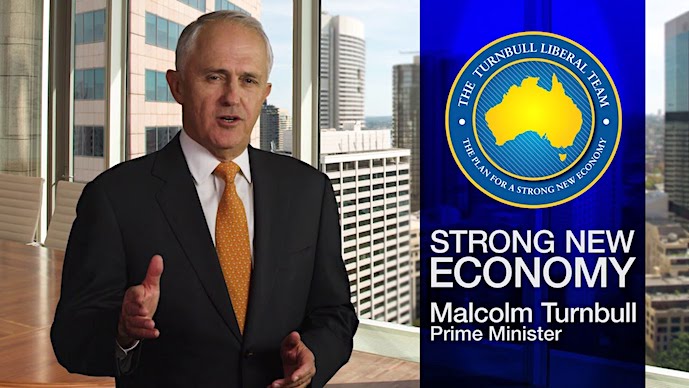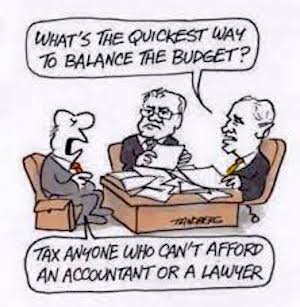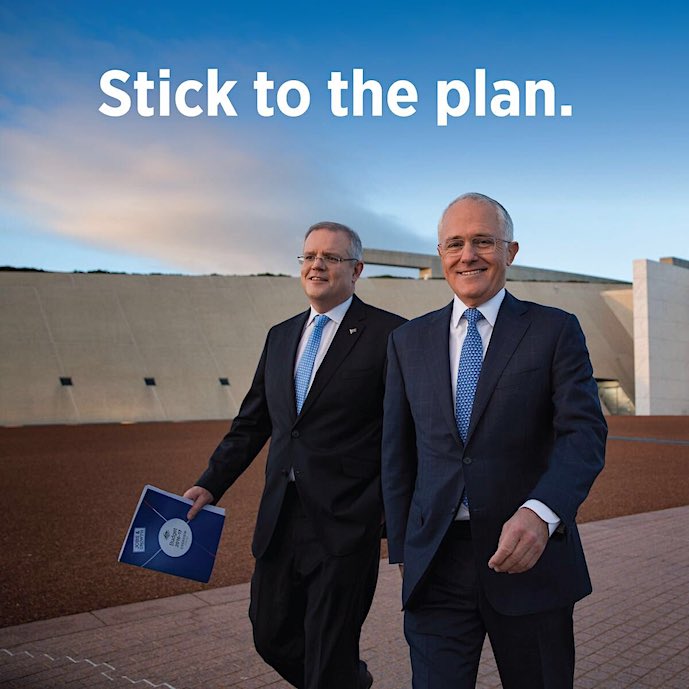
Let’s stand back from the daily tumult of federal politics momentarily, hard though it is to ignore, and look into the distance. What do we see? Given that politicians believe their role is to make this nation a better one for us all, where is the evidence of them planning to make it so?
Where is the Turnbull Team's much touted 'Plan for a Strong New Economy' that the logo promised?
Let us start with a recent calamity – the electricity blackout in South Australia. The complexities of how this came about will be explained by Chief Scientist Alan Finkel’s enquiry. This is not the place to predict its outcome, but already there is evidence of a lack of planning that has contributed to this disaster.
Although the States and energy generators and providers have responsibility for energy supply, the federal government has overriding responsibility for energy security – indeed
Environment and Energy Minister Josh Frydenberg declared the day after the calamity that
"Energy security is the federal government’s number one priority." Did anyone hear him uttering these weighty words anytime
before it occurred. No. This was a newfound mantra, now so important that it supplanted the Coalition’s top priority – national security. Turnbull concurred.
Which raises the question of exactly how much planning the feds had made to ensure energy security. Had they contemplated the effect that intermittent (
or asynchronous) energy generation from renewables might have on the electricity grid and the constancy of supply?
They have known for years that renewable energy generation has been rising steadily. At the end of 2015 there were
77 wind projects, with 2064 turbines generating 4187 MW of power, with a further 365 MW under construction. Almost a year later there are many more. As at March 2015, in addition to household solar panels, there were over
one hundred solar projects generating 4,100 MW of photovoltaic solar power.
This is not restricted information – it is freely available on the Internet. Yet there seems no evidence that the federal government and its Energy Minister have undertaken any planning to integrate intermittent power generated by wind or sun into a network that hitherto has been powered by regular base-load power generated from burning fossil fuels. There are complex arrangements already in place to modulate the level of power in the grid, which allow changes to the levels of power occasioned by intermittent power inputs. These arrangements are said to have failed during the fierce SA storm with its gusts of up to 140km an hour and over 80,000 lightening strikes, which took down 22 power transmission pylons and three transmission lines.
The consequent sudden drop in energy frequency in the network triggered an automatic cut at the interconnector with Victoria to protect the national network. SA Premier Jay Wetherill said: "
The system behaved as it's meant to behave to protect the national energy market", but the federal Energy Minister and the PM seemed not to understand this reality, nor were they prepared to take any responsibility for this vulnerability despite trumpeting that ‘energy security was their top priority’. What they did do immediately though was to make political capital by castigating State Labor governments for their ‘unrealistic and ideologically-driven targets for wind power’; thereby insinuating that reliance on wind power was a prime cause of the disaster.
Frydenberg then called an urgent meeting with State energy ministers to discuss how the national electricity grid might be better protected in future. Why was this the first such meeting?
If ever there was an example of a gross planning deficit at a federal level, this is it. A Turnbull planning black hole!
Marriage equality
The marriage equality issue is another example of poor planning. Propelled by the promise to his right wing to continue Abbott’s policy, Turnbull has persisted with the plebiscite idea, which will be stone dead once the Senate rejects it.
Turnbull, despite his personal support for marriage equality and his proclaimed confidence that both the people and the parliament would support it strongly, has no Plan B. For him, Plan A, the plebiscite, is all there is. Other leaders have been able to change their mind in the face of an alternative view in the electorate (Mike Baird springs to mind), but so controlled is Turnbull by his conservative rump, which refuses to even consider a Plan B, that he will not to listen to the increasing public clamour for marriage equality and the rising desire for a parliamentary vote rather than an expensive and divisive plebiscite. A sound planner would have anticipated that the long and loudly voiced resistance to a plebiscite by Labor, the Greens and several crossbenchers in the Senate would eventually kill the plebiscite plans, leaving him with nothing.
Bernard Keane of
Crikey has this cryptic view: “
…there is a Plan B, even if the Prime Minister won’t discuss it. It’s to hope the issue that has hovered over federal politics for more than a year goes away, put off until at least the next election!”
2353NM analyses this issue at length in
Turnbull – Abbott from a better postcode.
Turnbull’s lack of an alternative plan for introducing marriage equality is another planning black hole, one that is distressing to the LGBTI community. He ought to have anticipated the outcome now upon him and have planned an alternative approach.
Budget planning
This constitutes another black hole.
How long have we had to endure the ideologically driven budget planning that started with Joe Hockey and was continued by Scott Morrison and Mathias Cormann? We know that it is based on supply-side (trickle down) economics, which benefits the top end of town but penalises those lower down the pecking order. We know that the touted benefits of increased investment, more jobs and better pay for the workers are illusory, unsupported as they are by historical evidence accumulated over many decades. Yet they persist, driven by their ideological disdain for the ‘leaners’ whom they insist depend on the ‘lifters’ who work hard and pay their taxes.
You might be interested to view this You Tube video by economist Robert Reich, former labor secretary to US president Bill Clinton, which addresses this issue:
It goes on still. Only last week the Coalition, backed by Labor, passed a bill that embraces trickle-down economics – the Income Tax Relief Bill – which will drop the marginal tax rate for the $80,000-$87,000 bracket from 37 to 32.5 per cent. This was reported upon comprehensively in
The New Daily, an abbreviated version of which follows:
Treasurer Scott Morrison sold it as an income tax cut for “middle income” workers, but The Australia Institute insists it’s not a cut for middle earners because average income earners don’t earn anything like $80,000 a year. Anyone on $80,000 a year is in the top 25 per cent of income earners, and this figure doesn’t include age pensioners, the unemployed, and the disabled. If they were added in, it would push those on $80,000-plus close to the top 10 per cent. While it’s true the average full-time worker earns just over $80,000, that figure is misleading; the Institute’s economist pointed out that when part-time workers are factored in, the average wage drops to $1575 a week, which works out to roughly $60,000 a year.

It’s even worse for women. The average female worker earns only $925 a week, which is about $48,000. Female workers constitute only 39 per cent of those who earn $80,000-plus.
Not only will the tax cut not benefit ‘middle’ Australia, but it will cost the Budget $3.9 billion over the next four financial years.
Giving an extra $315 a year to low-income earners would ensure it was spent immediately, resulting in much-needed economic stimulus, whereas higher earners are likely to bank more of their tax cut – trickle down will not occur.
There
are other approaches. Take Mark Dayton, Democrat governor of Minnesota, who won office in 2010. This is what the
US blog Mic had to say about his approach:
“Since 2011, Minnesota has been doing quite well for itself. The state has created more than 170,000 jobs, according to the Huffington Post. Its unemployment rate stands at 3.6% - the fifth lowest in the country, and far below the nationwide rate of 5.7% - and the state government boasts a budget surplus of $1 billion. Forbes considers Minnesota one of the top 10 in the country for business.
“Given that Dayton is a well-connected millionaire whose family controls the Target fortune, one could be forgiven for thinking this was the result of embracing the corporate world. But in fact, over the past four years, the state has undergone a series of policy reforms that most of the corporate world decries: It has imposed higher taxes on the wealthy and raised the minimum wage. (My emphasis)
“When each of these progressive policies was initially proposed, Minnesota Republicans made dire predictions about their effects on the economy, and argued that bleeding-heart concerns about economic fairness would stifle growth. Despite all the warnings, Minnesota's economy hasn't tanked. Instead, it's sailing with greater force than it has in years.”
The
Mic article contrasts this with the situation in the adjoining state Wisconsin.
“As Minnesota has enjoyed economic success, observers have often compared the state's situation to that of its neighbor Wisconsin. Republican Scott Walker also won the governor's mansion in Wisconsin in 2010, but pursued a deeply conservative agenda for managing the economy. He made huge spending cuts to vital services ranging from education to health care. He reduced taxes on the wealthy, and got rid of tax credits for low-wage earners. (My emphasis)
By a number of measures, Wisconsin hasn't fared as well as Minnesota. As the Milwaukee Sentinel Journal documents, Wisconsin's job growth has been among the worst in the region, and income growth is one of the worst in the country. It has a higher unemployment rate than Minnesota. And the budget is in bad shape.
This is just one example; there are others. But it illustrates two vastly different approaches to economics: one that increases taxes on the wealthy and increases the minimum wage, and the opposite: one that reduces taxes for the rich and cuts services, and shows that the former is superior.
Why can’t Turnbull, Morrison et al consider approaches other than the traditional conservative one of cutting services and giving tax breaks to the well off? Why haven’t they got a Plan B? The truth is that this is another Turnbull ideologically driven planning black hole. So driven are they by their supply side ideology that believes economies are stimulated by giving tax cuts to the top end of town, that they are unable to consider an alternative approach. The have a Plan A, but no Plan B. This planning black hole leaves them shackled to a discredited economic policy.
In their economic planning, have they ever considered the merits of Modern Monetary Theory as described by Ken Wolff in
Modern Monetary Theory and will it help? The answer is: 'almost certainly no'.
What Government planning is evident as we approach an economy where many jobs will be automated, both manual and cognitive, and unemployment and underemployment will rise? Have they thought about and planned for the ‘gig economy’ described by Ken Wolff in
Are governments ready for the coming economic and social changes? The short answer is: ‘not that any of us can see!’
Economic planning is among the government’s poorest efforts, leaving us all vulnerable, and many of us worse off.
Inequality
There is now abundant evidence that inequality is a social burden for millions of people in our country and in many others. A large part of the phenomenon we witness day after day as America prepares for its presidential election is the direct result of vast swathes of the nation feeling left behind, while the political establishment does little to elevate them from their impoverished state. Thus people like Bernie Sanders, who press for more equality, excites many followers, and even the arch-capitalist Donald Trump attracts supporters by promising to
fix the ‘corrupt’ political establishment that he claims cares little for them.
We know too from the work of Professor Michael Marmot that
health inequality runs parallel to economic inequality. Those with the least, those with the poorer jobs, have the worst health.
In
The neoliberal execution of democracy, Ken Wolff describes in detail how neoliberal politics promote inequality. He quotes Noam Chomsky: “
Neoliberal democracy, instead of citizens, produces consumers…The net result is an atomized society of disengaged individuals who feel demoralized and socially powerless” Where are the Turnbull government’s plans for decreasing inequality? The Coalition is doing nothing to ameliorate the growing inequality that exists; indeed their neoliberal actions are making it worse.
Climate change
Here is where planning by the Turnbull government is so appalling. We know that its Direct Action Plan, Plan A, is a fraud. At this historic time when the world has crossed the threshold for the Paris agreement to take effect, the United Nations is challenging Australia’s policy. A report in
The Age only last week read:
“Australia is facing renewed international pressure to explain what it is doing to tackle climate change, with a United Nations review finding its emissions continue to soar. Several countries are calling for clarity about what it will do after 2020. Countries including China and the US have put more than 30 questions to the Turnbull government, asking for detail about how Australia will meet its 2030 emissions target and raising concerns about a lack of transparency over how the government calculates and reports emissions.
“It comes as the federal government has been facing calls at home - sparked by its own criticism of ambitious state renewable energy targets - to reveal what it would do on climate change and clean energy beyond 2020. An expert review commissioned by the UN found, based on data submitted by Australia, its emissions would be 11.5 per cent higher in 2020 than they were in 1990.”
The Turnbull government has no Plan B for mitigating global warming even although Plan A continues to be ineffective.
GST in WA
Malcolm Turnbull made a big pre-election political play when in Western Australia about its unfair share of GST revenue and promised to fix it. Several months later there is no fix, nor is there any plan to do so. In his quest for
a fairer share of GST for WA, and in the absence of any action by Turnbull, Brendon Grylls, (who is also attempting to regain his position as Leader of the WA Nationals), is promoting a mining tax, which would increase WA’s GST take. He is highly critical of Turnbull for having no plan to match his words.
Here’s another planning black hole with which the Turnbull government is riddled!
I could go on and on, but let’s finish with a laughable procedural planning shemozzle.
Procedural non-planning
With just a one-seat majority, it would be reasonable to expect careful planning in the area of parliamentary procedure. But already, in just a couple of months, the Turnbull government has suffered three defeats on the floor of the House because some of its members decided to leave on an early flight home, and last week Kelly O’Dwyer managed to embarrass the government through a procedural bungle by accidentally endorsing a bill amended by Labor, which criticized the Government. Of course she, the Manager of Government Business, Christopher Pyne, and the PM tried to play down the incident, but observers see it as a metaphor for the awful planning of the Turnbull government.
Whichever way we turn, wherever we look, we see either no planning in critically important areas, or faulty planning that imperils the Turnbull government, and of course we the citizens who depend on government to do those things that keep us safe, that enhance our prosperity, that give each of us a fair go, that enable us to be part of an integrated multicultural society which cares for all its citizens, rich and poor, able and disabled, healthy and ill.
The Turnbull government is letting us down badly because of its many planning black holes.
And sadly there is no sign that planning will improve in the time ahead.

Current rating: 0.4 / 5 | Rated 14 times